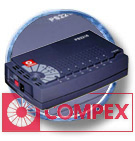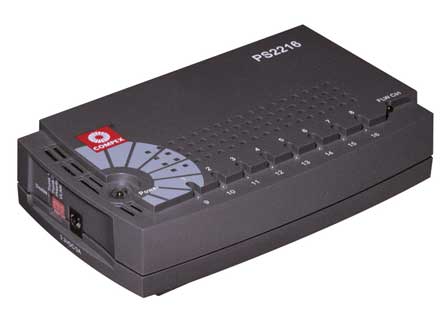Compex PS2216 Introduction
 Compex ReadyLink PS2216
Compex ReadyLink PS2216
16-port 10/100 Fast Ethernet Desktop Switch
Price: ~$60 USD, Guru3d.com PriceWatch reports 47 USD
The Small, But Mighty
As you might have figured out, we here at guru3d.com have a slight fetish for network equipment. When you take that freshly painted hot-rod game machine you've spent dozens of hours building to a LAN party, you have to hook it up to a LAN. Yup. It's hard to play games these days without a network of some kind.
The Complex PS2216 is a 16-port switch and is a rather small, dark grey, box. It's not your usual thin, square metal box that one imagines when you think about network equipment. It's about the size of the power brick for a laptop, or about two times bigger than the mouse you're waving around. The real attraction for the PS2216 is the cost per port, which is about $4. Throw in a few of the neat features like port trunking and VLAN support, and you've got a pretty handy, if not inexpensive, switch.
Bits, Frames, and Packets
Let's take a little overview of network equipment. At the bottom of the network food-chain you get the repeater. It does nothing but takes the bits, boost their signal, and send them on their way. Repeaters were the standard way to get around the 100 meter limit for cable. Just above that is the hub, similar to a repeater and just as dumb, it generally just has lots of ports. Hubs don't do anything to segregate data and treats all the computers attached to it as a single broadcast domain. That is, a hub forwards all packets to all ports and leaves it up to the nodes to decide if the packet was for them. Not the most efficient way to network, but it works well for smaller networks. Second from the top is the switch, which is what the PS2216 is. Switches treat each port as an individual broadcast domain, sending data (frames) only to the port that needs it, thus enhancing speed and efficiency. This level of intelligence requires that a switch have some buffer memory and have a little processing be done with each packet that goes in and out. At the top of the network food-chain is the router. Routers can contain switches. It is the big daddy of networks, as it works with the highest level of intelligence, by protocol.
Switches are generally a good upgrade if you have lots of hubs and want to extend the life of your network and kick up the speed.

